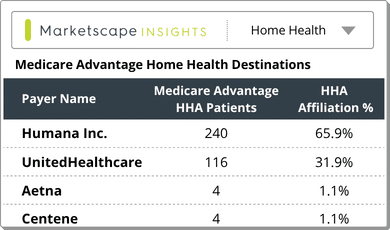BLOG
Referral Targeting Strategies Series: New Diagnostic Categories
By: Liz Gombosi | Deember 3, 2020
Increasing your agency’s market share and, as a result, growing both admissions and revenue begins with a strategic approach to targeting physicians in your area. One of the key ways to do this is by building out specialty programs that serve the needs of specific diagnostic categories – cardiac or respiratory, for example.
In our last post, we discussed how to tailor your specialty programs based on the diagnostic categories that meet both of the following criteria – the category comprises a large portion of your county or state’s patient mix and is a category in which your agency outperforms your competitors in patient outcomes. You’ll often see a correlation between your agency’s patient mix and that of your broader market. But what if there are categories prevalent in your market but not frequently treated at your agency? How can you break into new diagnostic categories to meet the needs of patients in your market?
Strategy 5: Breaking into New Diagnostic Categories
Unlike our core targeting strategies, you won’t begin identifying the ideal physician targets by looking at your top referral sources. Instead, it would help if you focused on understanding the broader patient mix in your market – and how your agency currently compares.
Once you know where you want to focus, you’ll need to spend more time understanding these patients’ specific needs to help you build a specialty program – tactically and operationally – that will perform. You can still use your performance metrics in other categories to make a case for your agency’s dedication to patient outcomes. However, this conversation will center more on learning, listening, and letting the market’s needs drive your path forward. Once built, marketing and communicating the plans and roadmap for your specialty programs – from staff and training to measurable results – will help you break into a new category – and hopefully tap into a new revenue stream.
To build a specialty program that meets the needs of your market, take the following approach:
Evaluate your Opportunities for Improvement
To break into something new, you first need to understand where you’re not performing well. When looking at your agency’s patient mix, look at the broader trends for your county and state. What categories have the largest presence in your market? Now, take compare that to your own patient mix and put your high percentage categories to the side. Or, better yet, work on a different strategy for those guys.
What county and state-leading categories make up the lowest percentage of your patient mix? Is there a gap in the market that you’re not filling? A low correlation between your top categories and those in your market is indicative of growth opportunity. Now, you need to build a value story around your offerings and performance for patients in this category.
Know the Competition
Once you’ve identified the new diagnostic categories you’d like to build specialty programs around, you need to look at your top competitors. What percentage of their patient mix falls into your target categories? Take a look at their patient outcome metrics for that category as well as their marketing materials. How are they promoting their affiliation with these categories? Are there any areas in which they fall short? How can you build a better specialty program?
Outline your Specialty Program
Armed with your market and competitive intelligence, it’s time to start outlining the details of your specialty programs. Consider the following:
- Why are you focusing on these categories? What’s the benefit to the patients and physicians in your market? Show them metrics of the overall patient mix as well as any market-level shortcomings or gaps that you’re looking to address.
- What do patients in these categories need in their post-acute care providers? Your goal is to show that you understand and are prioritizing patient outcomes in these categories.
- How do you need to change from an operational and tactical standpoint? Do any of these changes need services or expertise that overlap with things you already provide?
- Based on your agency’s outcomes in other diagnostic categories and the plan you’ve outlined, how do you expect to perform in your new diagnostic categories?
Identify your Targets
Once you feel confident in both the operational and messaging strategy for your new diagnostic categories, you can narrow your outreach efforts to focus on ideal physicians and facility targets:
- For physicians with which you already have a referral relationship, explore their patient mix. How does it correlate to yours? If a large percentage of their patient mix is comprised of your target diagnostic category, but your agency only receives patients in other categories, it’s a good idea to approach them with your plan. You’re already a known entity to them, so connect the dots between your established performance and your expected outcomes for a large group of their patients.
- Targeting new practices or physicians based on their specialty is another good place to start. While specialty and diagnostic category aren’t exactly the same, there is some correlation that can help you narrow the field. When you’ve identified the physicians or facilities that align with the specialty program you’re moving into, compare your performance to their existing referral destinations in other categories. It won’t be an apples-to-apples comparison, but you’ll be able to draw some parallels.
- If there are competitors in your market who specialize in the diagnostic category that you’re growing into, find out where their referrals are coming from, then compare your overall performance to theirs. If there’s a noticeable difference, you can draw parallels again to infer the performance metrics they could expect with you.
Engage in a Conversation
Once you’ve built your specialty program and identified your target referral partners, it’s time to start marketing your agency as the up-and-coming post-acute care destination in that diagnostic category. You already know your audience’s challenges – they want to ensure the best post-acute care outcomes for their specialty patients. In order to prove that your agency fits the bill, speak to the metrics that matter for them.
- How are you planning to exceed your competitors by providing better post-acute care for patients in these categories?
- How do you compare to their other top destinations? Look for the destinations with the biggest disparity in patient outcomes and start there. Key metrics for a home health agency to share include:
- Total Cost of Care
- Readmission Rate
- Apply your track record in overall patient outcomes – or other, similar diagnostic categories – to project outcomes they might see by switching to your agency.
What’s next?
Because you’re breaking into an entirely new specialty or diagnostic category, you won’t have firm performance metrics to rely on. That said, an established history of success in other diagnostic categories coupled with a solid business plan for how to serve this new category can lend credence to your pitch and give you a solid foundation on which to build your new specialty program. Remember, however, that building a new program is much like making a scientific discovery. You need to approach it methodically, constantly monitor its progress and outcomes, make adjustments when needed, and frequently report back on the end results. Schedule regular meetings with your referral partners to nurture the relationship and prove your value in this new diagnostic category.
Trella Health customers have access to all the metrics we discussed in this article. For more information on how to use Marketscape to identify specific diagnostic categories to target or to create sales collateral, contact your Customer Success Manager or request personalized training.
If you’re interested in learning more about how Marketscape from Trella Health can help you improve patient care and increase admissions with this and other targeting strategies, schedule your personalized demonstration today.
For more information on any of the targeting strategies we previously discussed, check out our resources page. Want help with a targeting strategy we haven’t covered? Drop us a line at [email protected]!














